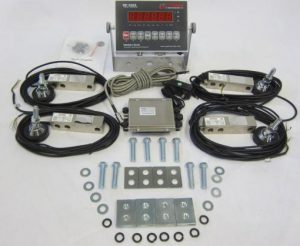Continuing a series that we started the last couple of years, we’re going to take a look at a DIY video and offer our opinion and thoughts on a Do it Yourselfer’s attempt at building a 5 x 5 platform scale. So, let’s get started.
The overall video is nicely done and the final product seems to be a decent platform scale. The welding and overall construction is well done too. The man in the video bought his scale kit on Amazon it appears (we sell better quality build your own scale kits) as you probably already know. The reason we say it’s a better kit is the components are NTEP approved items and they are a little higher quality than the ones shown in this low cost build your own scale kit. You can see a few times when they zoom in on the brand name load cells, it just says A & A and doesn’t mention a brand like Revere Transducers for example. It also doesn’t show a NTEP CoC#.
In case you don’t know, many online scale sellers find numerous ways to cut costs and offer cheaper and cheaper solutions. Unfortunately, we see it all the time…. from non-ntep computing scales which aren’t legal for trade to utilizing super cheap weight indicators which are almost impossible to setup and calibrate (if English is your first language). But we’ll save that for another entry… let’s continue with this review.
The man in the video doesn’t seem to show how he mounted the junction box. Normally this would be placed inside or under the scale platform and all the load cell cables would be sent to that box and the summing board. We can’t really see if that’s what he did or not. Another concern is the individual load cell cables. There are four of them. How are they run from each corner of the scale to the junction box? Are they inside a protected channel? Are they out in the open? Perhaps, tie wrapped below the deck? Obviously, the more exposed those load cell cables are, the more prone you are to get an error from a cable that gets ripped or slightly cut. And sometimes rodents like to chew on load cell cables too.
Maybe he mentioned this but we didn’t catch it, how much weight is he putting on the scale? This design is probably ok for lighter weight amounts but when you start weighing larger amounts above a ton, homemade scale platforms like these often tend to flex and not weigh as accurately as true scale manufacturer designed and engineered scale platforms that have passed NTEP certification.
He mentions the costs in the video which is helpful. Seems like he was around $400 or so…. Obviously, he spent a smaller amount of money than he would have buying a professional grade platform scale. However, as we often mention in these DIY scale videos, he doesn’t mention the value of his time spent building this scale. We are also not fans of the low cost plastic junction box and plastic weight indicator that are used in this kit. These items are some of the cheaper options available in the market and for just a little bit more $$ you could get a stainless steel junction box and either a stainless steel weight indicator or a painted steel weight indicator.

Overall, the build your own platform scale kit review video was informative, easy to follow along, and probably helps out a few folks every month who are looking to build their own scale for general weighing situations that might periodically occur. This type of scale would not be permitted to be used in a commercial setting where money is changing hands. And, we would not recommend going this route if you’re planning on using the scale daily. As we mentioned above and in previous posts, we would recommend purchasing our scale kit since it includes a little higher quality components like load cells, junction box, and weight indicator and items that are NTEP quality.
If you have questions or would like some assistance on choosing the right scales or scale kits, be sure to contact our customer service department for assistance.